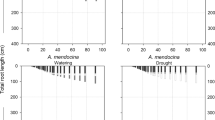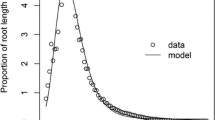Abstract
Determining the variation in roots traits within a grass root system is important for understanding the role of fine roots in carbon and nutrient cycling in grassland ecosystems, where the majority of biomass and litter accumulation occur belowground. However, few studies have been conducted in this regard. In this study, the structural and chemical traits of shoot-derived and root-derived roots were examined in three perennial grasses—Cleistogenes squarrosa, Achnatherum sibiricum and Stipa grandis—aiming to explore structural differences, responses to nitrogen and water addition in different types of roots and their correlations with aboveground plant nitrogen. Our results showed significant differences between these two root types, with root-derived roots having higher N concentration, tissue density, and specific root length, but lower C: N and diameter than shoot-derived roots. Trait relationships between root N concentration and tissue density for the two root types differed from that reported among species. These traits in different types of roots were insensitive to resource addition. Furthermore, N concentration in shoot-derived roots was more strongly linked to aboveground plant N concentration than root-derived roots. The results of this study demonstrate structural differences within the root system that may reflect functional heterogeneity in grass roots.




Similar content being viewed by others
References
Bai YF, Wu JG, Xing Q, Pan QM, Huang JH, Yang DL, Han XG (2008) Primary production and rain use efficiency across a precipitation gradient on the Mongolia plateau. Ecology 89:2140–2153
Chen ZZ, Wang SP (2000) Typical steppe ecosystems of China (in Chinese). Science, Beijing
Comas LH, Eissenstat DM (2004) Linking root traits to maximum potential growth rate among eleven mature temperate tree species. Funct Ecol 18:388–397
Cornelissen JHC, Aerts R, Cerabolini B, Werger MJA, van der Heijden MGA (2001) Carbon cycling traits of plant species are linked with mycorrhizal strategy. Oecologia 129:611–619
Craine JM, Lee WG (2003) Covariation in leaf and root traits for native and non-native grasses along an altitudinal gradient in New Zealand. Oecologia 134:471–478
Craine JM, Lee WG, Bond WJ, Williams RJ, Johnson LC (2005) Environmental constraints on a global relationship among leaf and root traits. Ecology 86:12–19
Craine JM, Froehle J, Tilman DG, Wedin DA, Chapin FS III (2001) The relationships among root and leaf traits of 76 grassland species and relative abundance along fertility and disturbance gradients. Oikos 93:274–285
Eissenstat DM (1991) On the relationship between specific root length and the rate of root proliferation: a field study using citrus rootstocks. New Phytol 118:63–68
Eissenstat DM (2000) Root sturucture and function in an ecological context. New Phytol 148:353–354
Eissenstat DM, Achor DS (1999) Anatomical characteristics of roots of citrus rootstocks that vary in specific root length. New Phytol 141:309–321
Eissenstat DM, Wells CE, Yanai RD, Whitbeck JL (2000) Building fine roots in a changing environment: implications for root longevity. New Phytol 147:33–42
Fitter AH (1982) Morphometric analysis of root systems: application of the technique and influence of soil fertility on root system development in two herbaceous species. Plant Cell Environ 5:313–322
Fitter AH, Stickland TR (1992) Architectural analysis of plant root systems.III. Studies on plants under field conditions. New Phytol 121:243–248
Fornara DA, Tilman D (2009) Ecological mechanisms associated with the positive diversity-productivity relationship in an N-limited grassland. Ecology 90:408–418
Gordon WS, Jackson RB (2000) Nutrient concentrations in fine roots. Ecology 81:275–280
Guo DL, Mitchell RJ, Hendricks JJ (2004) Fine root branch orders respond differentially to carbon source-sink manipulations in a longleaf pine forest. Oecologia 140:450–457
Guo DL, Xia MX, Wei X, Chang WJ, Liu Y, Wang ZQ (2008) Anatomical traits associated with absorption and mycorrhizal colonization are linked to root branch order in twenty-three Chinese temperate tree species. New Phytol 180:673–683
Hishi T (2007) Heterogeneity of individual roots within the fi ne root architecture:causal links between physiological and ecosystem functions.J For Res 12:126–133
Hishi T, Takeda H (2005) Dynamics of heterorhizic root systems- protoxylem groups within the fine-root syetem of Chamaecyparis obtuse. New Phytol 167:509–521
Hodge A, Berta G, Doussan C, Merchan F, Crespi M (2009) Plant root growth, architecture and function. Plant Soil 321:153–187. doi:10.1007/s11104-009-9929-9
Hooper DU, Johnson L (1999) Nitrogen limitation in dryland ecosystems: responses to geographical and temporal variation in precipitation. Biogeochemistry 46:247–293
Jackson RB, Mooney HA, Schulze ED (1997) A global budget for fine root biomass, surface area, and nutrient contents. Proc Natl Acad Sci USA 94:7362–7366
Kosola KR, Dickmann DI, Paul EA, Parry D (2001) Repeated insect defoliation effects on growth, nitrogen acquisition, carbohydrates, and root demography of poplars. Oecologia 129:65–74
Majdi H, Damm E, Nylund JE (2001) Longevity of mycorrhizal roots depends on branching order and nutrient availability. New Phytol 150:195–202
Pan QM, Bai YF, Han XG, Yang JC (2004) Studies on the fate of labeled nitrogen applied to Leymus Chinensis community of typical steppe in Inner Mongolia grassland (in Chinese). Acta Phytoecol Sin 28:665–671
Pregitzer KS (2002) Fine roots of trees—a new perspective. New Phytol 154:267–273
Pregitzer KS, Hendrick RL, Fogel R (1993) The demography of fine roots in response to patches of water and nitrogen. New Phytol 125:575–580
Pregitzer KS, Kubiske ME, Yu CK, Hendrick RL (1997) Relationships among root branch order, carbon, and nitrogen in four temperate species. Relationships among root branch order, carbon, and nitrogen in four temperate species. Oecologia 111:302–308
Pregitzer KS, Laskowski MJ, Burton AJ, Lessard VC, Zak DR (1998) Variation in sugar maple root respiration with root diameter and soil depth. Tree Physiol 18:665–670
Pregitzer KS, DeForest JL, Burton AJ, Allen MF, Ruess RW, Hendrick RL (2002) Fine root architecture of nine North American trees. Ecol Monogr 72:293–309
Reich PB, Walters MB, Ellsworth DS (1997) From tropics to tundra: Global convergence in plant functioning. Proc Natl Acad Sci USA 94:13730–13734
Reich PB, Tjoelker MG, Pregitzer KS, Wright IJ, Oleksyn J, Machado JL (2008) Scaling of respiration to nitrogen in leaves, stems and roots of higher land plants. Ecol Lett 11:793–801
Ryser P (1996) The importance of tissue density for growth and life span of leaves and roots. Funct Ecol 10:717–723
Ryser P (2006) The mysterious root length. Plant Soil 286:1–6
Ryser P, Lambers H (1995) Root and leaf attributes accounting for the performance of fast- and slow-growing grasses at different nutrient supply. Plant Soil 170:251–265
Scheurwater I, Cornelissen C, Dictus F, Welschen R, Lambers H (1998) Why do fast- and slow-growing grass species differ so little in their rate of root respiration, considering the large differences in rate of growth and ion uptake? Plant Cell Environ 21:995–1005
Silver WL, Miya RK (2001) Global patterns in root decomposition: comparisons of climate and litter quality effects. Oecologia 129:407–419
Strand AE, Pritchard SG, McCormack ML, Davis MA, Oren R (2008) Irreconcilable differences: fine-root life spans and soil carbon persistence. Science 319:456–458
Tjoelker MG, Craine JM, Wedin D, Reich PB, Tilman D (2005) Linking leaf and root trait syndromes among 39 grassland. and savannah species. New Phytol 167:493–508
Valenzuela-Estrada LR, Vera-Caraballo V, Ruth LE, Eissenstat DM (2008) Root anatomy, morphology and longevity among root orders in Vaccinium corymbosum (Ericaceae). Am J Bot 95:1506–1514
Volder A, Smart DR, Bloom AJ, Eissenstat DM (2005) Rapid decline in nitrate uptake and respiration with age in fine lateral roots of grape: implications for root efficiency and competitive effectiveness. New Phytol 165:493–502
Wang ZQ, Guo DL, Wang XR, Gu JC, Mei L (2006) Fine root architecture, morphology, and biomass of different branch orders of two Chinese temperate tree species. Plant Soil 288:155–171
Wahl S, Ryser P (2000) Root tissue structure is linked to ecological strategies of grasses. New Phytol 148:459–471
Wells CE, Glenn DM, Eissenstat DM (2002) Changes in the risk of fine root mortality with age: A case study in Peach, Prunus persica (Rosaceae). Am J Bot 89:79–87
Withington JM, Reich PB, Oleksyn J, Eissenstat DM (2006) Comparisons of structure and life span in roots and leaves among temperate trees. Ecol Monogr 76:381–397
Wright IJ, Westoby M (2004) The economics of leaves. Aust Sci 25:34–38
Wright IJ, Reich PB, Westoby M et al (2004) The world-wide leaf economics spectrum. Nature 428:821–827
Acknowledgments
We thank Weijun Wu, Yanfang Chen, Cui Xue and Shuxia Liu for their help with the field and laboratory work. We are also grateful to Dr. Guangming Zhang for his suggestions on the experimental design and comments on the manuscript and two anonymous reviewers for their valuable comments on this manuscript. This study was funded by an Innovative Research Group Project of National Natural Science Foundation of China (No. 30821062).
Author information
Authors and Affiliations
Corresponding authors
Additional information
Responsible Editor: Peter J. Gregory.
Electronic supplementary material
ESM 1
(DOC 84 kb)
Rights and permissions
About this article
Cite this article
Kong, D., Wu, H., Wang, M. et al. Structural and chemical differences between shoot- and root-derived roots of three perennial grasses in a typical steppe in Inner Mongolia China. Plant Soil 336, 209–217 (2010). https://doi.org/10.1007/s11104-010-0467-2
Received:
Accepted:
Published:
Issue Date:
DOI: https://doi.org/10.1007/s11104-010-0467-2




